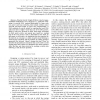Free Online Productivity Tools
i2Speak
i2Symbol
i2OCR
iTex2Img
iWeb2Print
iWeb2Shot
i2Type
iPdf2Split
iPdf2Merge
i2Bopomofo
i2Arabic
i2Style
i2Image
i2PDF
iLatex2Rtf
Sci2ools
AINA
2010
IEEE
2010
IEEE
Routing Loops in DAG-Based Low Power and Lossy Networks
Abstract—Directed Acyclic Graphs (DAGs), rooted at popular/default destinations, have emerged as a preferred mechanism to provide IPv6 routing functionality in large scale low power and lossy networks, that include wireless sensor networks and those based on power line communication. A DAG maintains its acyclic nature by requiring that each DAG node must have a higher ’rank’ than any of its DAG parents. While a node may decrease its DAG rank safely, increasing its DAG rank to add a new parent may result in a routing loop if the new parent is also a descendant in the DAG. In this paper, we first study via simulations the time required by the network to converge to a stable, loop-free state following a rank increase operation and the number of routing messages generated (the network ’churn’) during this time. Then, we describe the precautionary measures that can be used to avoid routing loops and evaluate via simulations how these measures affect the time and churn involved in...
| Added | 10 Jul 2010 |
| Updated | 10 Jul 2010 |
| Type | Conference |
| Year | 2010 |
| Where | AINA |
| Authors | Weigao Xie, Mukul Goyal, Hossein Hosseini, Jerald Martocci, Yusuf Bashir, Emmanuel Baccelli, Arjan Durresi |
Comments (0)

